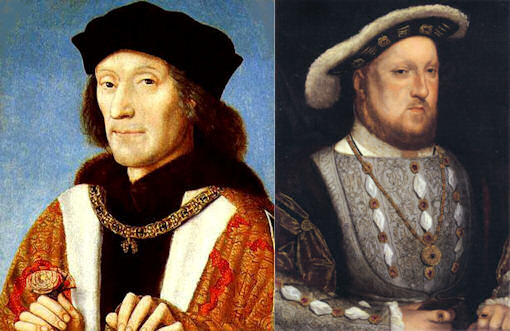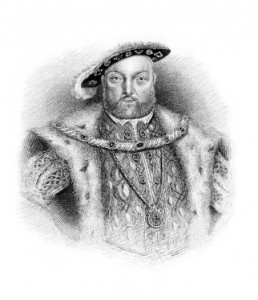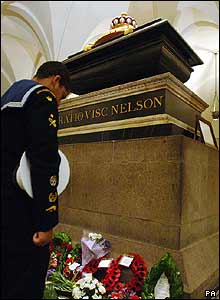It is interesting that on this day in 1457 Henry VII was born and on this day in 1547 (weird digit thing going on here!) his son, Henry VIII, shuffled off this mortal coil. So, Happy 554th Birthday to one Henry and RIP to the other!

The Birth of Henry VII
Henry VII was born on the 28th January 1457 at Pembroke Castle on the south-west coast of Wales. His father was Edmund Tudor, 1st Earl of Richmond, and his mother was Lady Margaret Beaufort. Henry’s paternal grandparents were Owen Tudor, a former page to Henry V, and his wife, Catherine of Valois, the widow of Henry V and mother of Henry VI. His maternal grandfather was John Beaufort, 1st Duke of Somerset, and his maternal great-grandfather (John Beaufort, 1st Earl of Somerset) was a son of John of Gaunt, 1st Duke of Lancaster, and his mistress (and later wife), Katherine Swynford. It was from this Beaufort side of the family that Henry VII derived his claim to the throne.
Lady Margaret Beaufort was only 13 years old when Henry was born and she was already a widow, his father having died from the plague three months earlier while imprisoned by Yorkists. Margaret had been taken in by her brother-in-law, Jasper Tudor, Earl of Pembroke, the man who helped bring Henry up, who took him into exile in Brittany and who helped him win the crown of England. David Starkey writes of how Henry’s birth must have been difficult for Margaret, “with her youth and diminutive stature”1, and perhaps that is why Margaret never had any more children. Poor Margaret, I can just imagine her terror as she gave birth in a cold castle, in the middle of winter and in a country where “the plague still raged”2. I wonder if she had any idea of who this baby would become!
You can read more about Henry VII in the following articles:-
- Henry VII Marries Elizabeth of York
- The Battle of Bosworth 1485 Part 1 – The Wars of the Roses
- The Battle of Bosworth 1485 Part 2 – The Battle
- Lady Margaret Beaufort
- The Coronation of Henry VII
- Elizabeth of York
The Death of Henry VIII
By late December 1546, it was clear that Henry VIII was gravely ill. In these last days, the King’s Council met and the decision was made to arrest Henry Howard, Earl of Surrey, and his father, Thomas Howard, 3rd Duke of Norfolk. Surrey had unwisely boasted about his Plantagenet blood and said that when the King died, his father would be “meetest to rule the prince”3. Allegedly, Surrey had plotted “to kill the Council, depose the king and seize the young prince”4 and also persuade his sister, Mary Howard to become the new king’s mistress. If that wasn’t enough, he had also had the audacity “to quarter his own arms with those of Edward the Confessor”5. Surrey was tried, found guilty of high treason and sentenced to death. He was beheaded on the 19th January 1547.
Surrey’s father, the Duke of Norfolk, had apparently been making secret visits to the lodgings of Marillac, the French ambassador, under cover of darkness, and when he was arrested in December 1546 he was questioned about his use of a secret cipher and whether he was loyal to the Royal Supremacy. In his biography of Henry VIII, J. J. Scarisbrick6, writes of how it is hard to know whether it was Surrey who dragged his father down, or the other way round, and also whether the attack on the Howards came from a faction in the Council or from a “suspicious, ruthless and fearful old man who was determined to be master of his own kingdom even unto the grave.”7 Fortunately for Norfolk, although he had been found guilty of treason and sentenced to death, the King died the day before he was due to be executed and his sentence was commuted to imprisonment. He was released in 1553.
But let’s get back to Henry VIII…
 When an ill Henry VIII returned to Whitehall from Oatlands, via Nonsuch, it was to an empty court. His wife, Catherine Parr, had been sent away to Greenwich for Christmas and the court had been closed. Only the King’s Privy Council and trusted attendants were present. Although his council were spreading the news that the King had been suffering with a fever caused by his leg and was on the mend, the truth was that the King was dying and that his last will and testament were being drawn up. Scarisbrick writes of how, on the night of the 26th December 1546, Dudley, Hertford, Paget, Denny and two other men were called to see the King. Henry ordered Denny to fetch his will but got mixed up and brought him the wrong one, an earlier one. Denny then found the correct will, one drawn up by Wriothesley, and read it out to the King. The King was surprised at its contents, saying that he was not happy with the list of executors and councillors, so Paget made the corrections ordered by the King, one of which was removing the name of Stephen Gardiner, Bishop of Winchester – “a wilful man”8, according to the King. Four days later, on the 30th December, Hertford, Paget and Sir William Herbert visited Henry and the will was signed, witnessed and sealed with the King’s signet ring.
When an ill Henry VIII returned to Whitehall from Oatlands, via Nonsuch, it was to an empty court. His wife, Catherine Parr, had been sent away to Greenwich for Christmas and the court had been closed. Only the King’s Privy Council and trusted attendants were present. Although his council were spreading the news that the King had been suffering with a fever caused by his leg and was on the mend, the truth was that the King was dying and that his last will and testament were being drawn up. Scarisbrick writes of how, on the night of the 26th December 1546, Dudley, Hertford, Paget, Denny and two other men were called to see the King. Henry ordered Denny to fetch his will but got mixed up and brought him the wrong one, an earlier one. Denny then found the correct will, one drawn up by Wriothesley, and read it out to the King. The King was surprised at its contents, saying that he was not happy with the list of executors and councillors, so Paget made the corrections ordered by the King, one of which was removing the name of Stephen Gardiner, Bishop of Winchester – “a wilful man”8, according to the King. Four days later, on the 30th December, Hertford, Paget and Sir William Herbert visited Henry and the will was signed, witnessed and sealed with the King’s signet ring.
On the 3rd January 1547, the French Ambassadors, De Selve and La Garde, wrote to Francis I telling him that they had been told by the King’s Council that the King was now well, after they had not been allowed to see the King on the 1st January due to his illness9. On the 16th January, Henry had improved enough to receive the French and Imperial ambassadors and De Selve and La Garde reported that the King “seems now fairly well”10. It is unclear when the King suffered a relapse but on the 27th January the King was too ill to be present at the commission which agreed on the Duke of Norfolk’s attainder.
By the evening of the 27th, it was clear to Henry VIII’s doctors that he did not have long to live, although they refrained from doing so in case they were accused of treason for foretelling the King’s death. Sir Anthony Denny was the one who advised Henry that he must prepare himself. Scarisbrick writes of how the King “began to think on his past life and its shortcomings, saying, ‘yet is the mercy of Christ able to pardon me all my sins, though they were greater than they be.’ “11 When Denny asked the King if he wanted a church man to minister to him, the King replied that he would like Cranmer there but “I will first take a little sleep and then, as I feel myself, I will advise upon the matter.”12 The King slept for a couple of hours and then asked for Cranmer who had to travel from Croydon. By the time Cranmer got to Whitehall, Henry was unable to speak, and was slipping in and out of consciousness. Cranmer asked Henry to give him some sign that he trusted in God and Henry “holding him with his hand, did wring his hand in his as hard as he could.”13 Henry VIII died in the early hours of the 28th January 1548, although his death was kept secret until the 31st January, giving his Council time to discuss what was going to happen.
 The King’s embalmed body was taken by chariot to Windsor Castle on the 14th February. On the 16th February, the “wilful man”, Stephen Gardiner, presided over Henry’s funeral mass in the Castle’s St George’s Chapel. Henry’s body was laid to rest in a vault between the stalls and altar, the grave where his third wife, Jane Seymour, had been buried. Although Henry had planned for he and Jane to be laid to rest in a magnificent tomb in the Lady Chapel, a tomb which Cardinal Wolsey had actually had designed for himself, the tomb was not finished. In 1646 Parliament ordered that the ornaments of the tomb should be sold and the sarcophagus ended up being the tomb of Lord Nelson (1758-1805) and standing in St Paul’s Cathedral. Not what Henry wanted at all and it seems that he did not get his way regarding the reign of his son, Edward, either. Henry VIII had appointed executors and councillors to help his son rule, yet one man, Edward Seymour, became the Lord Protector. Henry could not do anything about it except roll in his grave.
The King’s embalmed body was taken by chariot to Windsor Castle on the 14th February. On the 16th February, the “wilful man”, Stephen Gardiner, presided over Henry’s funeral mass in the Castle’s St George’s Chapel. Henry’s body was laid to rest in a vault between the stalls and altar, the grave where his third wife, Jane Seymour, had been buried. Although Henry had planned for he and Jane to be laid to rest in a magnificent tomb in the Lady Chapel, a tomb which Cardinal Wolsey had actually had designed for himself, the tomb was not finished. In 1646 Parliament ordered that the ornaments of the tomb should be sold and the sarcophagus ended up being the tomb of Lord Nelson (1758-1805) and standing in St Paul’s Cathedral. Not what Henry wanted at all and it seems that he did not get his way regarding the reign of his son, Edward, either. Henry VIII had appointed executors and councillors to help his son rule, yet one man, Edward Seymour, became the Lord Protector. Henry could not do anything about it except roll in his grave.
“The King is dead. Long live the King”. Henry VIII was dead and gone and his young son was now King Edward VI.
You can read more about Henry VIII’s death and will in:-
Notes and Sources
- Henry: Virtuous Prince, David Starkey, p19
- Ibid.
- Henry VIII, J.J. Scarisbrick, p622
- Ibid.
- Ibid
- Ibid., p622-623
- Lacey Baldwin Smith quoted by Scarisbrick, p623
- Scarisbrick, p629
- LP xxi. part 2. 662
- Ibid., 713
- Scarisbrick, p638
- Ibid.
- Ibid